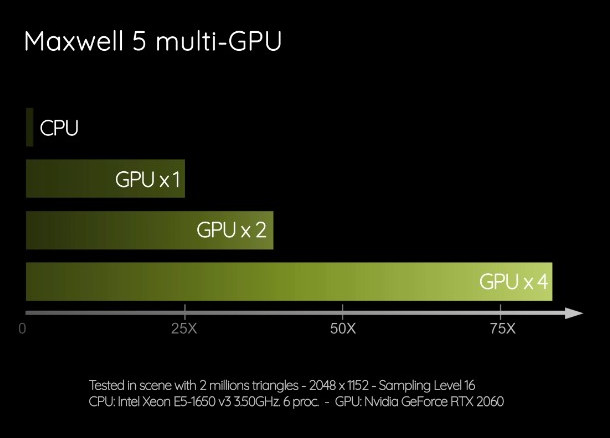Next Limit ships Maxwell 5.2
Originally posted on 5 November 2019. Scroll down for details of the 5.2 update.
Next Limit has released Maxwell 5.0, the next major update to its physically based spectral renderer, adding multi-GPU support, integrated cloud rendering, and a V-Ray scene importer.
The release also updates the user interface to display better on modern Hi-DPI displays.
The release is the first significant update to Maxwell in some time: Maxwell 4.0 came out in 2016, and the last bugfix update was over 18 months ago.
A performance-focused update, for both preview and final-quality rendering
Performance is a key focus of the update, with speed increases in both preview and final-quality rendering.
Fire, the software’s interactive render preview, is “now faster and optimized to update instantly”.
The video at the top of the story shows the GPU version of Fire being used to preview a scene with over 3 million triangles, although there’s no information about which graphics card is being used.

Support for multiple GPUs in Maxwell GPU
In addition, Maxwell GPU, the CUDA-based GPU render engine introduced Maxwell 4.0, now supports multiple GPUs, for a “more than 50x speed-up compared with a high-end CPU”.
The benchmark on the product website, reproduced above, suggests that you’d need to be using at least three GPUs to see that kind of speed boost, but that performance scaling is relatively close to linear.
Maxwell GPU can also now handle additive materials, although there are still a number of Maxwell features that the engine doesn’t support, including procedural textures, coatings and SSS.
You can see a feature comparison table of the CPU and GPU render engines here.
Other changes: light grouping in Multilight, UI scaling on Hi-DPI displays
Other changes include the option to group lights and treat them as a single emitter in Multilight, Maxwell’s toolset for adjusting the colour and intensity of light sources in an image after rendering.
The interface has also been reworked to display better on modern high-resolution displays “4K or higher”.
Workflow improvements include support for nested references, making it easier to work with complex scenes; and the option to search for scene dependencies in file paths with up to three levels of subfolders.
In Maxwell Studio only: built-in cloud rendering, new V-Ray scene importer
Users of the standalone edition of the renderer, Maxwell Studio, also get built-in access to a new cloud rendering service, Maxwell Cloud.
As with Chaos Cloud, the equivalent feature in V-Ray, sending a render to the cloud is a one-click operation, although currently, you can only render using the CPU engine.
At the time of posting, Maxwell Cloud instances are 96-core Intel Xeon machines with 86.4GB of RAM.
To use the service, you need to buy credits online in advance, which entitle you to rent individual machines by the hour, with prices starting at €40 (around $44) for 10 machine-hours of rendering.
The Studio edition also includes a V-Ray scene importer, which automatically converts V-Ray materials and lights into their Maxwell equivalents for rendering.
Similar importers are “coming soon” in the application-specific versions of Maxwell.

Updated 15 May 2020: Next Limit has released Maxwell 5.1.
The update adds Substance Painter assistant, a new tool for streamlining the process of converting the texture maps generated by Adobe’s 3D painting tool into Maxwell materials.
Other changes include support for coated materials and “much better support” for transparent materials in Maxwell GPU; and new versions of Benchwell, Maxwell’s benchmarking tool, for both CPU and GPU.
Updated 12 March 2021: Next Limit has released Maxwell 5.2.
The release overhauls the software’s render denoiser, which is now implemented as a channel within Maxwell, reducing memory overheads, and exposing new control parameters, shown in this video.
In addition, Multilight now runs on the GPU engine, while the GPU engine itself now natively supports Nvidia’s new Ampere GPUs, including the GeForce RTX 30 Series and RTX A6000.
There is also a new Substance Designer assistant along the lines of the Substance Painter assistant added in 5.1, this one automatically translating procedural materials in .sbsar format into Maxwell materials.
Pricing and availability
Maxwell Studio 5.2 is available for Windows 7+ and Windows Server 2008+, Linux and macOS 10.11+. Maxwell GPU is CUDA-based, so it requires a Nvidia GPU. See detailed specs and a list of supported GPUs here.
Application-specific editions are available for 3ds Max, ArchiCAD, Cinema 4D, form.Z, Maya, Rhino and SketchUp. The Modo edition is no longer available in Next Limit’s online store.
New perpetual licences of Maxwell Studio and the integrated editions are now priced identically, at $595 for a node-locked licence or $795 for a floating licence. Prices include one additional render node.
Multilight is a free download for Windows, Linux and macOS.
Read more about new features in Maxwell 5 on the product website
Read a full list of new features in Maxwell in the online changelog
